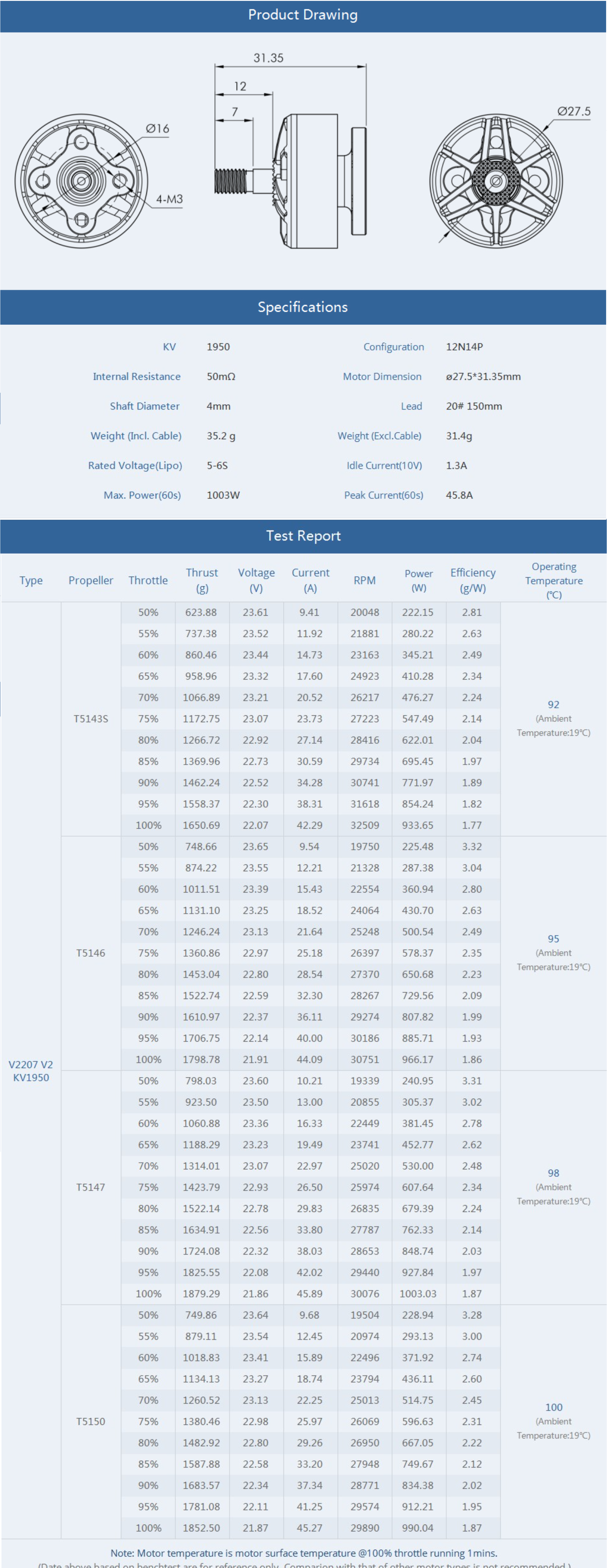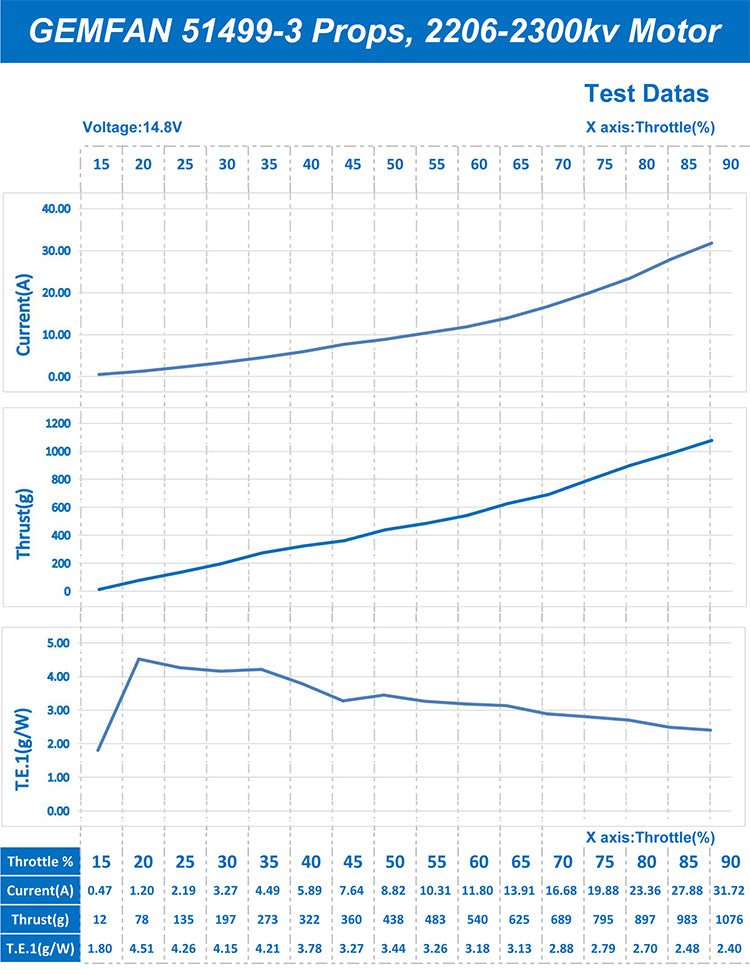SKU510073 QAV250 Frame Kit

Carbon fiber-ARM: 3mm
Height: 37mm
Wheelbase: 250mm
Weight:148g
SKU520041 BLHeli S ESC 20A

Main features
● EFM8BB21F16G MCU, pipelined 8-bit C8051 core with 50 MHz maximum operating frequency.
● Dedicated high frequency driver, makes the start more smooth. ESC maximum speed is 500k eRPM.
● BLHeli-S firmware is designed for superior performance in multirotors, and uses hardware generated motor
pwm for smooth throttle response and silent operation.
● Damped light does regenerative braking, causing very fast motor retardation, and inherently also does active
freewheeling.
● Supports higher KV motor and more power load, more suitable for violent flight of racing drone .
● The code supports regular 1-2ms pulse width PWM input, as well as Oneshot and Multshot . The input signal is
automatically detected by the ESC upon power up.
● Supports Dshot150, Dshot300 and Dshot600.Dshot is digital signal, anti-interference ability is stronger, and
do not need throttle calibration.
● The silicone twisted-pair of the throttle signal cable increase the service life,and effectively reduces the crosstalk caused by signal transmission,and makes flight more stable.
Specifications
Model: BLHeli-S ESC
Con. Current:20A
Burst Current(10S):30A
BEC:NO
LiPo cells:2-4S
*BLHeli-S is using the A-H-30 BLHeli-S firmware
Programming parameter
Programming parameters below can be accessed from the configuration software (BLHeliSuite):
1. Startup power:
Startup power can be set to relative values from 0.031 to 1.5. This is the maximum power that is allowed during startup. Actual applied power depends on throttle input, and can be lower, but the minimum level is a quarter of the maximum level. Startup power also affects bidirectional operation, as the parameter is used to limit the power applied during direction reversal. For low rpms, the maximum power to the motor is limited,in order to facilitate detection of low BEMF voltages. The maximum power allowed can be set via the startup power parameter.
2. Commutation timing:
Commutation timing can be set to low/mediumlow/medium/mediumhigh/high, that correspond to 0°/7.5°/15°/22.5°/30° timing advance.Typically a medium setting will work fine, but if the motor stutters it can be beneficial to change timing. Some motors with high inductance can have a very long commutation demagnetization time. This can result in motor stop or stutter upon quick throttle increase, particularly when running at a low rpm. Setting timing to high will allow more time for demagnetization, and often helps.
3. Demag compensation:
Demag compensation is a feature to protect from motor stalls caused by long winding demagnetization time after commutation. The typical symptom is motor stop or stutter upon quick throttle increase, particularly when running at a low rpm. As mentioned above, setting high commutation timing normally helps, but at the cost of efficiency.Generally, a higher value of the compensation parameter gives better protection. If demag compensation is set too high, maximum power can be somewhat reduced.
4. Direction:
Rotation direction can be set to fwd/rev/bidirectional fwd/bidirectional rev. In bidirectional mode, center throttle is zero and above is fwd rotation and below is revers e rotation. When bidirectional operation is selected, programming by TX is disabled.
5. Beep strength: Sets the strength of beeps under normal operation.
6. Beacon strength:
Sets the strength of beeps when beeping beacon beeps. The ESC will start beeping beacon beeps if the throttle signal has been zero for a giventime. Note that setting a high beacon strength can cause hot motors or ESCs!
7. Beacon delay: Beacon delay sets the delay before beacon beeping starts.
8. Programming by TX: If disabled, throttle calibration is disabled.
Please notice that throttle stick can calibrate throttle range only, and can not programming paramenter via throttle stick .
9. Min throttle, max throttle and center throttle:
These settings set the throttle range of the ESC. Center throttle is only used for bidirectional operation. The values given for these settings are for a normal 1000us to 2000us input signal, and for the other input signals, the values must be scaled.
10.Thermal protection:
Thermal protection can be enabled or disabled. And the temperature threshold can be programmed between 80°C and 140°C(from rev16.3).The ESC measures temperature within the MCU and limits motor power if the temperature is too high. Motor power is limited in four steps:
- If the temperature is above threshold , motor power is limited to 75%.
- If the temperature is above threshold 5°C, motor power is limited to 50%.
- If the temperature is above threshold 10°C, motor power is limited to 25%.
- If the temperature is above threshold 15°C, motor power is limited to 0%.
11.Low RPM power protect:
Power limiting for low RPMs can be enabled or disabled. Disabling it can be necessary in order to achieve full power on some low kV motors running on a low supply voltage. However, disabling it increases the risk of sync loss, with the possibility of toasting motor or ESC.
12.Brake on stop:
Brake on stop can be enabled or disabled. When enabled, brake will be applied when throttle is zero. For nonzero throttle, this setting has no effect.
SKU520091 Motor 2207-KV1950
SKU520120 Motor 2207-KV1950 V2.0

SKU530136 Propeller(2Pair)


You may also like










